Choosing the Right Materials for Your Greenhouse
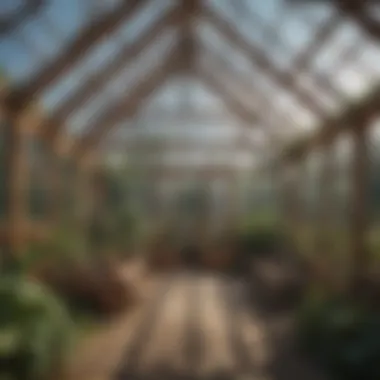

Intro
In today’s world, where the issues of climate change and food security loom large, the cultivation of sustainable practices in agriculture has gained paramount importance. Greenhouses serve as a beacon for this shift, providing a controlled environment for growing various crops regardless of external weather conditions. However, the choice of materials to construct a greenhouse can significantly affect its performance, longevity, and overall impact on the environment. Thus, making the right materials decision is key for both budding gardeners and seasoned enthusiasts.
Current Trends in Agriculture and Horticulture
As the agricultural landscape evolves, so does the need for innovative solutions aimed at efficiency and sustainability.
Overview of Recent Innovations
In recent years, the introduction of smart technology into greenhouse designs has become a game changer. These innovations include:
- Automated climate control systems that monitor temperature and humidity levels, adjusting them in real-time to optimize plant health.
- Hydroponic systems which allow plants to grow without soil, using mineral nutrient solutions instead. This method uses less water and results in faster growth rates.
- LED grow lights that enhance photosynthesis while consuming less energy.
It’s like giving plants their very own luxury spa treatment, ensuring they get just what they need to flourish without wasting resources.
Sustainable Practices Gaining Popularity
Another significant trend is the prioritization of sustainable materials. Builders are now leaning towards using recycled glass, bamboo, or polycarbonate, as these materials not only offer good insulation but also minimize environmental impact. Furthermore, greenhouse films made from biodegradable materials are paving the way toward more eco-friendly options.
"Sustainability isn’t just a buzzword; it's becoming standard practice in modern agriculture."
These practices are not just a trend; they suggest a shift toward longer-lasting structures that can contribute positively to the ecosystem.
Essential Farming Techniques
While selecting materials is important, it’s equally critical to understand the techniques that maximize the benefits of a greenhouse.
Soil Health Management
Soil health lays the foundation for any greenhouse operation. Employing techniques like crop rotation, cover cropping, and the use of organic amendments helps maintain and enhance soil vitality. Adopting practices that focus on nurturing beneficial microorganisms can improve nutrient uptake while ensuring the sustainability of the agricultural environment.
Pest and Disease Control Strategies
Mindfully managing pests and diseases is essential for the success of any greenhouse. Utilizing integrated pest management (IPM) strategies by incorporating natural predators and biological controls can help minimize chemical input. It’s about creating a balance where you protect your crops while safeguarding the surrounding eco-system.
Tools and Technology in Farming
Embracing today’s technological advancements adds a new dimension to greenhouse farming.
Overview of Advanced Farming Tools
Tools such as digital soil sensors, automated irrigation systems, and a host of greenhouse monitoring applications provide growers with unprecedented insights. These technologies not only make farming more efficient but also empower farmers to make data-driven decisions that optimize yield.
Case Studies on the Use of Technology
Several case studies highlight the effective use of technology. For example, an urban farm in Chicago employed precision agriculture tools, resulting in a 30% increase in crop yield when compared to traditional methods. This approach showcases how technology, when paired with the right materials, can revolutionize the way we approach greenhouse farming.
Prelude to Greenhouse Construction
When it comes to nurturing plants and extending growing seasons, understanding greenhouse construction is pivotal. Whether you are a seasoned farmer or a garden enthusiast, the structure of your greenhouse plays a vital role in determining both productivity and plant health. Building a greenhouse isn't just about setting up a frame and covering it; it revolves around thoughtfully selecting materials that enhance your growing environment.
Many factors come into play when considering the construction of a greenhouse. First off, the material choices for both the frame and the glazing can significantly influence heat retention and light transmission, leading to more favorable growing conditions. With increasing temperatures and climate variability, robust insulation is no longer a luxury but a necessity, ensuring your plants thrive regardless of outside conditions.
Moreover, the sustainability aspect cannot be ignored. The rising desire for eco-friendly practices in agriculture makes understanding the longevity and environmental impact of your material choices crucial. Using recycled or biodegradable materials not only decreases your carbon footprint but also encourages a more ethical approach to farming.
It’s also essential to think about the budget. The initial outlay for materials can vary greatly, and knowing how to balance cost with quality is key. Investing in durable materials can lead to long-term savings, as frequent replacements can quickly add up to more than the upfront expense of higher-quality options.
Incorporating these elements into your planning will ensure that your greenhouse serves its purpose effectively, maximizing both yield and efficiency. By the end of this article, it’s our aim for you to walk away with a comprehensive understanding of the various materials available for building a greenhouse, guiding you through optimal choices that align with your specific horticultural goals.
Fundamentals of Greenhouse Design
The design of a greenhouse is not merely an afterthought but rather an essential aspect that can significantly impact the effectiveness of plant cultivation. Understanding the fundamentals ensures that the structure maximizes light, manages temperature efficiently, and meets the horticultural needs of the plants grown within its walls. Anyone who has ventured into greenhouse construction will quickly realize that the careful planning of its design can make all the difference between a thriving space and a lackluster one.
Principles of Light and Heat Management
Light is the lifeblood of a greenhouse. Without adequate illumination, photosynthesis—a plant's way of making its food—comes to a standstill. It's crucial to consider how natural light enters the structure.
- South-facing glazing captures the maximum sunlight, especially in cooler months.
- Light diffusion materials can help to scatter sunlight, reducing the risk of hot spots that can damage sensitive plants.
Moreover, managing heat is just as vital. During summer, greenhouse temperatures can skyrocket if not properly ventilated. Incorporating features such as exhaust fans or roof vents promotes airflow and maintains an optimal environment for growth. A well-designed greenhouse will use thermal mass, such as gravel or water tanks, to store heat during the day and release it during the night, thus stabilizing temperature fluctuations.
"The right amount of light and the proper heat control mechanisms can transform your greenhouse into a flourishing sanctuary for your plants."
Orientation and Placement Considerations
The greenhouse's orientation and placement on the property should not be taken lightly. These factors play a pivotal role in the quantity of light received and the overall design's efficiency. Key considerations include:
- Proximity to water sources for easy irrigation.
- Natural windbreaks like trees or fences that can mitigate harsh winds.
- Accessibility for maintenance, ensuring you can easily manage the plants inside.
Typically, orienting the greenhouse north to south allows even light distribution throughout the day. However, in regions with particularly intense sun, an east to west orientation might be favored to reduce overheating. It's essential to survey the area throughout different seasons to observe how shadows cast by nearby structures or trees might affect light exposure.
By carefully evaluating these design fundamentals, prospective greenhouse builders can pave the way for a more efficient, productive, and enjoyable gardening experience.
Essential Structural Materials
Building a greenhouse is like assembling a puzzle. Each piece must fit perfectly to create a structure that stands strong against the elements while providing an ideal environment for plants to thrive. Essential structural materials serve as the backbone of any greenhouse. Choosing the right materials affects not just the initial cost, but also long-term durability, maintenance needs, and overall effectiveness in creating a conducive growing environment.
Above all, structural materials need to possess a few key characteristics: stability, resistance to weather impacts, and the ability to support the weight of the glazing and any additional loads like shelving or ventilation systems.
Wood as a Traditional Choice
Wood has long been a favored material for greenhouse construction, mainly due to its accessibility and versatility. It's readily available and can be easily worked with, making it an ideal choice for DIY enthusiasts. There are different types of wood, like cedar and redwood, renowned for their natural resistance to decay, which extends the lifespan of the structure significantly.
Still, there are considerations one must keep in mind:
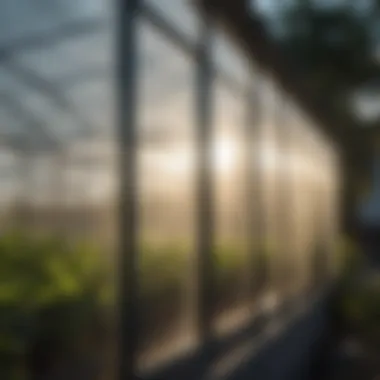
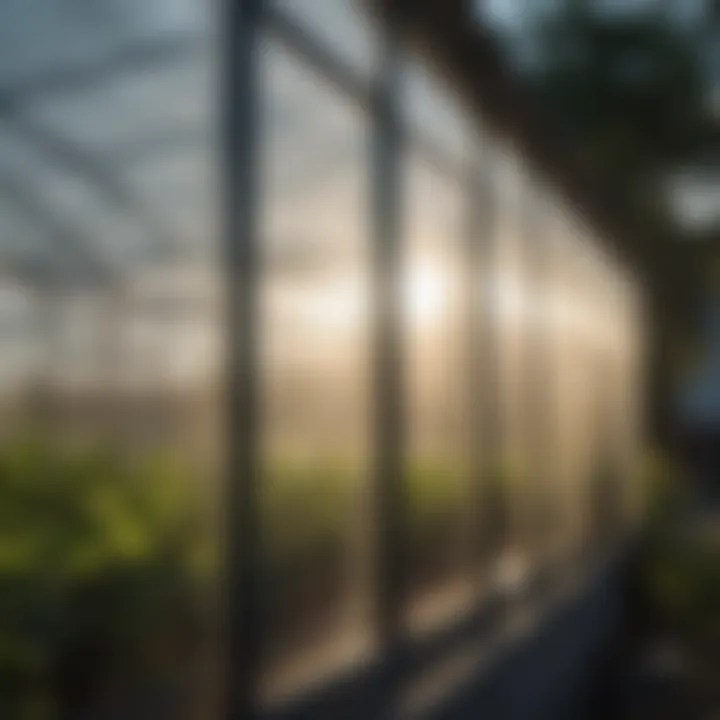
- Cost: Premium woods can be expensive. The choice between a higher upfront cost for quality wood versus a more durable option that requires less maintenance can be tricky.
- Treatment: Untreated wood may rot, especially in moist conditions. It’s crucial to invest in wood preservation methods to prolong its life.
Using wood can afford a truly organic feel to the greenhouse, complementing the natural beauty of plants and gardens.
"Wooden structures, if well-maintained, can outlast many synthetic materials in aesthetic appeal and longevity."
Metal Framework: Pros and Cons
Metal provides a modern touch to greenhouse construction. Options like aluminum or steel are popular due to their strength and resistance to bending or warping under stress. A metal framework lets you create a larger span without needing as many supports.
Pros:
- Durability: Metal is invulnerable to issues like rot or pests, unlike wood.
- Low Maintenance: Generally, once installed, there is not much fuss required compared to wooden structures.
Cons:
- Initial Costs: Metal frameworks can be pricier than wood, impacting your pocketbook from the start.
- Heat Conduction: Metals can absorb and conduct heat, which might lead to overheating if not managed properly.
Ultimately, the choice between wood and metal often boils down to specific project goals and personal taste.
Vinyl and Plastic Alternatives
The market for vinyl and plastic alternatives has exploded in recent years. These materials usually come in the form of PVC frames or polycarbonate panels, offering some unique benefits. The lightweight nature of these options makes them easy to transport and assemble, ideal for smaller installations.
Key Points in Considering Vinyl and Plastic:
- Cost-Effective: Typically, these materials are less expensive than traditional options, which can be a major factor for budget-conscious growers.
- Energy Efficiency: Many vinyl or plastic products come with insulation properties, aiding in temperature regulation within the greenhouse.
- Flexibility and Variety: These materials can often be molded to create unique shapes, allowing for creative designs. However, flexibility can sometimes lead to a compromise in stability compared to metal or wood structures.
In summary, while exploring the landscape of greenhouse materials, each category offers unique attributes that cater to different needs. The right choice hinges on one's priorities, whether it is longevity, cost, or aesthetic appeal. Each material brings its own flavor to the table, and understanding these elements helps in crafting the perfect greenhouse.
Glazing Options for Greenhouses
Glazing plays a pivotal role in greenhouse construction. It essentially serves as the transparent "skin" that allows sunlight to enter while providing some protection from the elements. The choice of glazing materials directly affects not only the aesthetics of the greenhouse but also its functionality. Factors such as cost, level of insulation, light transmission, and longevity all hinge on the glazing options selected.
A greenhouse’s primary job is to create an optimal environment for plants. Hence, it’s vital to choose a glazing material that strikes a balance between maximizing light while minimizing energy loss. The right choice can lead to healthier plants and greater yields, making this topic both critical and worthy of thoughtful consideration.
Glass: Advantages and Limitations
Glass is often the go-to choice for those looking for durability and clarity. One of its strongest attributes is light transmission. Glass can offer upwards of 90% light transmission, ensuring that your plants get the nutrition they need from the sun.
However, glass isn’t without its drawbacks. Weight is a significant issue—you’ll need a robust structure to support it. Additionally, glass tends to retain heat poorly, leading to potential temperature fluctuations that could stress your plants, especially on colder nights.
Also, consider the cost. While upfront expenses for glass may be high, you might save on longevity and lower maintenance fees in the long run. Here are some key points to consider:
- Advantages:
- Limitations:
- Excellent light transmission
- Long-lasting durability
- Aesthetic appeal
- Higher initial costs
- Heavy and requires strong structural support
- Less effective heat retention
Polycarbonate Sheets: An Evolving Choice
Polycarbonate sheets have been gaining popularity, and for a good reason. They are much lighter than glass, making them easier to handle during installation. They also offer similar transparency but with better insulation properties. In fact, polycarbonate can achieve an R-value of around 1.0 to 5.0, depending on thickness and whether it is double or multi-wall. This means they can better maintain interior temperature compared to glass.
Still, they do have their flaws. Polycarbonate can become discolored over time, which may lead to diminished light transmission. Also, some cheaper options might not be UV stabilized, resulting in quicker deterioration. Consider the following:
- Pros:
- Cons:
- Lighter weight
- Good insulation properties
- Impact-resistant, safer than glass
- Potential for yellowing
- Different qualities available, not all of which are UV stabilized
Polyethylene Films: Cost-Effective Solutions
Polyethylene films are a cost-effective choice for those on a tighter budget or those who want to experiment with greenhouse gardening. These films are lightweight and can easily be replaced, making them an attractive option for hobbyists or seasonal growers.
While they can offer a good level of light transmission, usually around 85%, the insulation properties are not as robust as other options. Typically, these films last for a few seasons before they need replacing, giving you flexibility but also the continued expense.
Here’s what to weigh:
- Benefits:
- Drawbacks:
- Low-cost alternative
- Adjustable; easy to replace
- Good light transmission
- Short lifespan
- Lower insulation value
"When selecting glazing for your greenhouse, remember that the right choice can significantly enhance your plants’ growth, all while providing a solid return on investment. Each type of glazing comes with its own set of advantages and challenges; understanding these is key to making an informed decision."
Insulation Materials and Techniques
When it comes to building a greenhouse, the importance of insulation materials and techniques cannot be overstated. Good insulation not only aids in maintaining favorable conditions within the greenhouse but also enhances energy efficiency, minimizing cost and environmental impact. A suitable insulation strategy will vastly improve the growing environment, protecting plants from external temperature swings and reducing the load on heating systems during colder months.
Key Benefits of Insulation in Greenhouses:
- Temperature Control: Insulation regulates internal temperatures, protecting delicate plants from temperature extremes.
- Energy Efficiency: Excellent insulation reduces heating costs in winter, conserving energy and contributing to a more sustainable operation.
- Plant Growth Promotion: A stable environment promotes healthier plant growth, as fluctuations in temperature can stress crops.
In essence, selecting the right insulation material is a crucial step toward creating an optimal space for agriculture environments, thus it deserves careful consideration.
Importance of Thermal Properties
Thermal properties refer to how materials behave in response to heat. In the context of greenhouses, they determine how well insulation can trap heat in winter and keep it out in summer. For instance, materials with high thermal resistivity help to prevent heat loss. Likewise, insulation acts as a barrier to unwanted heat from entering during the hotter months.
For a practical approach, focusing on materials with good resistance to thermal conduction can prove beneficial. They play a significant role in facilitating a conducive environment for plants, ensuring they receive consistent warmth and moisture as needed. Evaluating thermal properties involves considering not just the type of material, but also its thickness and installation method.
"Thermal performance can make or break the growth cycle of plants. Get it wrong, and the results can be disastrous for any crop."
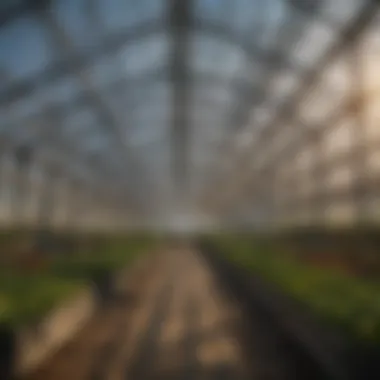
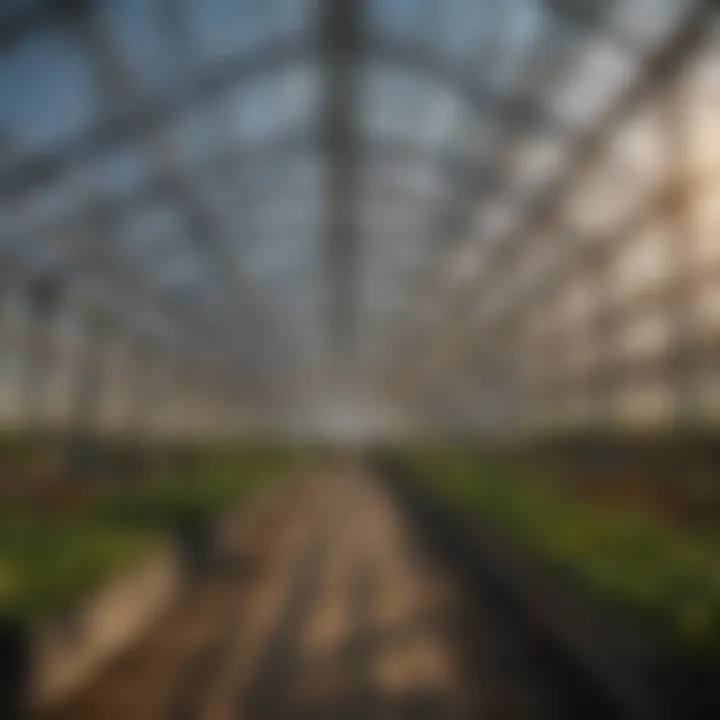
Comparing R-Values of Various Materials
R-value is a measure of thermal resistance, crucial for understanding how well an insulation material performs. Comparing R-values of different materials helps in deciding the most effective option for your greenhouse needs. Higher R-values indicate better insulating properties, which can translate into significant energy savings.
Here are some common materials and their corresponding R-values:
- Fiberglass: Typically ranging from R-2.9 to R-4.3 per inch, fiberglass is widely used for its affordability and effectiveness.
- Polyurethane foam: Known for its high R-value, around R-6 to R-7 per inch, this material offers superior insulation, making it a popular choice for energy-conscious builders.
- Spray Foam Insulation: Generally has an R-value of R-3.6 to R-7 per inch, depending on its density and installation. This option provides excellent air sealing capabilities as well.
In choosing insulation, balancing R-value with budget and material availability is vital. Ultimately, your choice should align with your greenhouse's specific climate and the crops you intend to cultivate.
Sustainable and Innovative Materials
Sustainable materials in greenhouse construction stand at the intersection of environmental friendliness, efficiency, and functional longevity. As the global focus on sustainability tightens, using innovative materials has become not just a trend but a necessity for responsible agricultural practices. By opting for these materials, one can reduce the carbon footprint related to greenhouse operations and contribute positively to the ecosystem. The significance of sustainable materials cannot be overstated, as they help in maintaining soil health, reducing waste, and conserving water.
Several benefits arise from the adoption of sustainable materials:
- Environmental Impact: By choosing recyclable or biodegradable options, gardeners can minimize waste and lower their ecological footprints.
- Cost-Effectiveness: Initially, some sustainable materials can come with a price tag that raises eyebrows. However, these materials often lead to long-term savings due to lower maintenance costs and increased durability.
- Innovation: New technologies are constantly emerging, leading to the development of materials that are not only functional but also enhance the aesthetic appeal of greenhouses.
Considering these factors, one can see that the shift towards sustainable and innovative materials isn't merely about meeting regulations; it's about embracing a forward-thinking approach to agricultural practices.
Recycled and Upcycled Materials
Recycled materials present a practical alternative, allowing one to give a second life to resources that would otherwise end up in landfills. These materials range from reclaimed wood to repurposed plastic. For instance, many garden enthusiasts have started using old pallets for framing their greenhouses. These pallets are not only cost-effective but, when treated properly, can ensure structural integrity.
Similarly, upcycling, which involves creatively repurposing discarded materials, opens a world of possibilities. Think of using discarded glass bottles or windows as glazing units. This not only reduces waste but also adds a quirky aesthetic that can suit certain garden designs beautifully.
- Examples of Recycled Materials:
- Wood from Old Buildings: This can be used to create frames or shelves, giving character and history to a greenhouse.
- Plastic Bottles: Cut and used as mini-greenhouses for young plants or for smaller structures within the greenhouse.
"Utilizing recycled materials not only saves money but also promotes resource conservation in gardening."
In a nutshell, the imaginative use of recycled and upcycled materials can lead to unique greenhouse designs while fostering an environmentally responsible mindset.
Biodegradable Options in Greenhouse Construction
Biodegradable materials present a layer of sustainability that goes beyond mere recycling. These materials decompose naturally, thus enriching the soil and minimizing waste. Options here range from bio-based plastics to organic compostable mulches.
Using materials like bamboo for structural supports or compostable fabric for greenhouse covers encourages a full-circle lifecycle approach. For example, bamboo is not only strong and lightweight, but it is also fast-growing, making it an excellent sustainable choice.
Some other biodegradable materials that could be beneficial include:
- Hemp: When used for coverings, hemp is both hardy and effective at blocking harmful UV rays.
- Coconut Coir: An excellent growing medium that breaks down over time, thus naturally enriching the soil.
By incorporating biodegradable materials into greenhouse construction, gardeners can not just manage their plants better but also support soil health and minimize waste. Given the urgent need for sustainable agricultural practices, understanding these innovative solutions is not just beneficial; it’s imperative.
Ventilation and Airflow Management
Proper ventilation and airflow management in a greenhouse is crucial for maintaining an optimal environment for plants. Plants breathe in carbon dioxide and release oxygen through a process known as photosynthesis. However, excess heat and humidity can be detrimental to their growth. This is where effective ventilation comes into play. It ensures that air within the structure is constantly circulating, thus preventing overheating and the buildup of moist air, which can lead to mold growth and other diseases.
Without adequate ventilation, a greenhouse may harbor stale air, which directly affects plant health and productivity. It becomes essential to understand various aspects of ventilation, including material choices for structures and the comparison of natural and mechanical systems, as these choices directly influence the success of your growing operations.
Material Choices for Ventilation Structures
When it comes to selecting materials for ventilation structures, one must consider both durability and efficiency. Commonly used materials include:
- Metal Grilles: Galvanized steel and aluminum are popular options due to their strength and resistance to rust. These materials ensure that air flows freely while providing a stable, long-lasting support structure.
- Plastic Louvers: These are lighter and often more cost-effective. While not as sturdy as metal, high-quality plastics can resist environmental stresses and are available in various designs.
- Screen Mesh: Integrating screen materials helps to keep unwanted pests out while allowing airflow. Options range from fiberglass to polyester, each choice having implications for durability and maintenance.
Each of these materials plays a vital role in achieving the desired airflow and can influence overall energy efficiency.
Natural vs. Mechanical Ventilation
Choosing between natural and mechanical ventilation is another key consideration in greenhouse design.
Natural Ventilation relies on the movement of air without mechanical assistance. This could be achieved through the strategic placement of vents, windows, and exhaust fans that encourage cross-ventilation.
Some benefits of natural ventilation include:
- Eco-friendly operation since it doesn’t rely on electricity, making it cost-effective over time.
- Enhanced humidity control, as opening vents can quickly dissipate excess moisture.
However, it does have some drawbacks:
- It can be ineffective on calm days, leading to poor airflow in such conditions.
- Design needs to be adaptable to changing weather patterns.
Mechanical Ventilation, on the other hand, uses fans and other equipment to regulate airflow. This approach allows for more precise control over temperature and humidity conditions inside the greenhouse.
The advantages of mechanical ventilation include:
- Consistent air circulation, regardless of external weather conditions.
- Enhanced control over the greenhouse environment, which can lead to optimal plant growth.
But it does come with its own considerations:
- Higher energy consumption can increase operational costs.
- Dependency on electrical systems means potential risks during outages.
In summary, successful greenhouse management hinges on an understanding of the materials and systems that contribute to effective ventilation and airflow management.
Balancing these aspects involves assessing the specific conditions of your location, the types of plants being grown, and your budget for both initial setup and ongoing operations. Understanding ventilation can significantly enhance the health and productivity of your greenhouse plants.
Water Management Systems
Water management systems play a crucial role in greenhouse construction as they directly influence the growth conditions for plants. A well-designed system not only supplies adequate moisture but also conserves resources and optimizes the growth environment. When discussing water management, we should consider irrigation methods, drainage solutions, and how these systems can impact overall greenhouse sustainability.
Effective water management ensures that plants receive the right amount of water to thrive. Too much or too little can dramatically impede plant growth and health—neglecting this element can lead to wasted resource and even crop failure.
Material Considerations for Irrigation
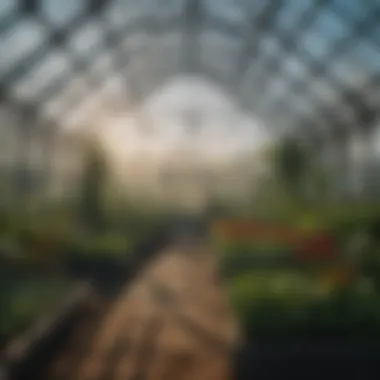
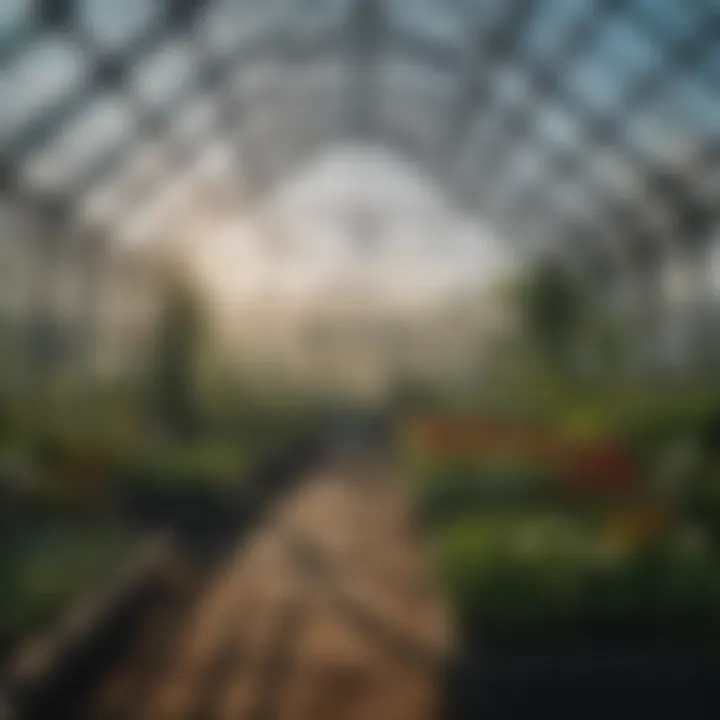
Choosing appropriate materials for irrigation can make a significant difference in the efficiency and sustainability of your greenhouse. Common materials utilized include:
- PVC Pipes: These are often favored due to their durability and resistance to corrosion. They are lightweight and easy to handle.
- Drip Irrigation Tubes: These materials ensure precise watering directly at the plant roots, reducing wastage and allowing for better control over moisture levels.
- Rainwater Harvesting Systems: Incorporating materials for collecting and storing rainwater can provide a sustainable water source. Gutter systems and storage tanks made from polyethylene or galvanized steel are popular choices.
Furthermore, sometimes using recycled materials for irrigation systems can add both eco-friendliness and innovation to your greenhouse setup. It’s essential to regularly assess your irrigation materials to ensure they are functioning optimally.
Drainage Solutions and Material Choices
Drainage is just as critical as irrigation when managing water in a greenhouse. Poor drainage can lead to waterlogging, which creates a breeding ground for pests and diseases. Therefore, selecting the right materials for drainage is key:
- Perforated Drainage Pipes: These pipes are installed beneath the soil surface to allow excess water to escape. They help maintain proper moisture levels in the plant root zone, preventing root rot.
- Geotextiles: These fabrics can be used to separate drainage materials from soil, promoting effective water movement without allowing soil to clog the system.
- Gravel and Rocks: Utilizing gravel in your drainage layer can provide excellent filtration and prevent clogs in the drainage systems.
In essence, ensuring that water management systems are designed thoughtfully is vital in creating a productive greenhouse environment. Optimal water supply and drainage do not just enhance plant health; they also contribute to the sustainability of water resources.
Proper water management systems are the backbone of greenhouse success, ensuring optimal conditions while promoting resource conservation.
Integrating these water management considerations into your greenhouse plans will not only lead to healthier plants but may also influence the overall efficiency of the agricultural operations.
Maintenance and Longevity of Materials
Maintaining the integrity and performance of materials used in greenhouse construction is a topic that deserves focused attention. It's one thing to choose the right materials, but ensuring their longevity is equally critical. Materials exposed to various weather conditions, humidity, and sunlight can deteriorate faster without proper care. Therefore, recognizing and implementing effective maintenance strategies can make a significant difference in extending the lifespan of your greenhouse. Durable materials not only reduce replacement costs but also enhance the overall functioning of the greenhouse, ensuring that the plants thrive within.
Assessing Durability of Various Materials
When it comes to durability, it is essential to look closely at the materials used in your greenhouse. Some materials stand the test of time better than others, and their durability can directly affect maintenance.
- Wood: Although wood is a classic choice, its durability largely depends on the treatment and type of wood used. Pressure-treated or cedar wood offers better longevity due to inherent resistance to decay and pests. However, even treated wood requires regular inspections for signs of rot or insect damage.
- Metal: Commonly aluminum and galvanized steel, these metals are robust alternatives. While they resist rust and general wear, they may need periodic checks for corrosion, especially in humid environments.
- Plastic and Vinyl: These materials often boast long life spans but can become brittle with excessive UV exposure. Regular cleaning and inspections can help maintain their structural integrity.
Understanding how each material fares over time is crucial for making informed choices that align with your greenhouse's unique needs.
Routine Care to Extend Lifespan
To ensure your greenhouse materials remain effective over time, implementing a regular maintenance routine is vital. Here are some strategies that can help:
- Regular Cleaning: Dust, debris, and algae can accumulate on surfaces, especially glazing. A gentle wash with a mild soap can work wonders to remove residues and allow for better light penetration.
- Inspections: Monthly checks are recommended for exposed wood to detect any signs of rot. Look for soft spots or discoloration and address them quickly. Similarly, inspect metal frameworks for rust spots and treat them accordingly.
- Repairs: Fix small issues before they escalate. A crack in polycarbonate isn’t just a cosmetic issue; it can lead to larger problems. Always have a repair kit handy to fix minor issues as they surface.
- Seasonal Adjustments: After heavy rain or storms, evaluate whether the structure has been compromised. Additionally, adjust ventilation openings to adapt to seasonal weather conditions.
"A stitch in time saves nine" is a fitting maxim here. Addressing maintenance needs promptly not only enhances longevity but also reduces larger repairs in the future.
By being proactive about maintenance, you enhance the reliability and functionality of your greenhouse. The effort you put into ensuring the materials last can significantly translate to healthier plants and, ultimately, better harvests.
Cost Analysis of Greenhouse Materials
In the realm of greenhouse construction, cost analysis emerges as a pivotal cornerstone in the decision-making process. Understanding the financial implications tied to different materials not only influences initial investment but also plays a significant role in the longevity and efficiency of the structure. Investing time to delve into cost considerations can yield substantial benefits in the long run—ultimately supporting your gardening aspirations and budgetary constraints.
The right choice of materials impacts not just the purchase price but also maintenance, energy consumption, and the overall productivity of your greenhouse. Whether you're a seasoned horticulturist or a newbie eager to cultivate a green sanctuary, discerning the costs associated with greenhouse materials is an essential part of fostering a successful growing environment.
Budgeting for Initial Investment vs. Long-Term Savings
When embarking on the journey of greenhouse construction, one must weigh initial costs against potential long-term savings. Choosing materials based purely on the lowest initial price can lead to hidden pitfalls down the line. For instance, while a plywood structure may seem economical at first glance, subsequent repairs due to rot can quickly add up.
It's vital to consider:
- Durability: Higher-quality materials may cost more up front, but they can save you from constant repairs and replacements.
- Energy Efficiency: Investing in better insulation materials could reduce heating costs significantly. Over time, the standing savings outweigh the cost of initial investment.
- Resale Value: A greenhouse built with durable, sustainable materials can fetch a higher price if you ever decide to sell your property.
By formulating a budget that encompasses projected operational costs, you can hone in on a long-term strategy that benefits both your wallet and your greenhouse productivity.
Comparing Costs Across Material Types
Different materials come with varying price tags, and these differences should never be dismissed lightly. Your choice can range from traditional wood to advanced synthetic options, and each has its unique financial landscape.
Here’s a brief breakdown of common materials:
- Wood: Generally affordable, good thermal properties, but may require regular treatment against pests and moisture. Maintenance costs should be factored in.
- Metal: Often comes with a higher upfront cost but offers robust longevity and minimal upkeep. It's worth considering if you prioritize durability.
- Plastic and Polycarbonate: While cheaper initially, the lifespan can differ significantly compared to glass or metal, requiring maintenance and eventual replacement.
- Glass: Offers unparalleled light transmission but is the most expensive option; yet, its durability could balance out costs over a longer timeframe.
"Investing in your greenhouse is not only about what you spend initially but what you save over the lifecycle of the construction."
Each material has its pros and cons, but analyzing them through an economic lens empowers you to make choices that enhance both your growing experience and financial health. Whether it’s conserving energy or reducing maintenance costs, having a keen eye for the costs associated with each material type will keep your greenhouse flourishing for years to come.
Final Thoughts on Material Selection for Greenhouses
Selecting the right materials for constructing a greenhouse is more than just an exercise in practicality; it’s a strategic choice that impacts the entire gardening experience. Each material comes with its own set of benefits and considerations that can enhance or hinder the efficacy of the greenhouse. In this section, we will delve into the significance of thoughtful material selection, emphasizing functional needs, durability, environmental impact, and the aesthetic appeal of the greenhouse.
Material selection should align with the gardener's goals. Factors like the intended crops, climate considerations, and personal budget dictate which materials will serve best. If you’re growing delicate plants, for example, optimal light transmission is crucial, while a sturdy frame will be necessary for harsher climates. This synergy ensures that the greenhouse not only looks appealing but also performs effectively under varying conditions.
A significant benefit of proper material choice lies in its implications for sustainable practices. With the rise of green initiatives, materials like recycled plastics or treated wood can be more attractive to environmentally conscious builders. Not only do these choices help minimize waste, but they also promote a cycle of sustainability in agriculture. Thus, when you think about materials, consider their lifecycle and eco-friendliness as well.
"Choosing the right materials is akin to laying a strong foundation; it supports everything else that follows."
Another key consideration involves the long-term savings associated with particular materials. While some options may involve a higher upfront cost, they offer durability and lower maintenance in the long run, which can save both time and money. So, assessing the total cost of ownership is essential – it’s not just about the initial hit to your wallet.
To wrap things up, material selection in greenhouse construction isn’t a step to breeze through; it’s a comprehensive process that demands your attention. Balancing functionality with aesthetics while considering sustainability and long-term value will lead to a greenhouse suited to your unique agricultural needs.
Balancing Functionality with Aesthetics
Building a greenhouse isn’t solely about practicality; aesthetics can significantly influence your gardening space. A well-designed greenhouse can enhance the overall landscape of your garden, making it a focal point rather than an eyesore. Envision walking into a garden where the greenhouse seamlessly blends with the surround natural beauty while serving its functional purpose.
It’s important to keep in mind that some materials offer both beauty and functionality. For example:
- Glass provides brilliant light transmission and looks elegant but may need solid framing.
- Vinyl or polycarbonate can be done in different shades and shapes, equipping you with variety.
Ultimately, finding the right balance is about aligning your needs with your vision. The aesthetic elements of the greenhouse should complement your garden's character while still serving the primary function of plant cultivation.
Choosing the Right Material for Your Goals
Deciding on materials for your greenhouse boils down to understanding your specific goals. Are you focusing on high-yield production or perhaps growing exotic plants? The answer to these questions will guide your material selection process.
Here are a few categories to think about:
- Climate Resilience: In a place where winters bite hard, investing in stronger frames and insulated glazing will benefit you.
- Plant Types: If you’re raising tropical plants, materials that offer higher light diffusion can help create an ideal environment.
- Budget Parameters: Seek materials that strike a balance between upfront cost and long-term growing success.
Assessing your unique situation is vital. Do your research and reflect on what really matters for your greenhouse. The right choice is out there, waiting to transform your gardening aspirations into reality.



